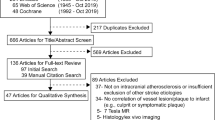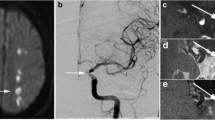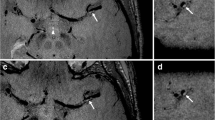Abstract
Purpose
Quantitative measures of vessel wall magnetic resonance imaging (vwMRI) for the evaluation of intracranial atherosclerotic disease (ICAD) offers standardization not available with previously used qualitative approaches that may be difficult to replicate.
Methods
vwMRI studies performed to evaluate ICAD that had caused a stroke were analyzed. Two blinded reviewers qualitatively rated culprit lesions for the presence of enhancement on T1 delay alternating with nutation for tailored excitation (DANTE) SPACE images. At least 3 months later, quantitative analysis was performed of the same images, comparing lesion enhancement to reference structures. Cohen’s kappa and intraclass correlation coefficients were calculated to assess agreement. Ratios of enhancement of lesions to references were compared to qualitative ratings.
Results
Studies from 54 patients met inclusion criteria. A mean of 49 (90.7%) lesions were qualitatively rated as enhancing, with good inter-rater agreement (κ = 0.783). Among reference structure candidates, low infundibulum demonstrated the highest inter-rater agreement on pre- and post-contrast imaging. The ratio of percentage increase in plaque signal following contrast to the same measure in low infundibulum demonstrated the highest agreement with qualitative assessment, with highest agreement seen with a ratio of 0.8 set as a threshold (κ = 0.675).
Conclusion
Quantitative metrics can yield objective data to better standardize techniques and acceptance of vwMRI evaluation of ICAD. The low infundibulum had the highest inter-rater agreement on both pre- and post-contrast images and is best suited as a normally enhancing reference structure. Such quantitative techniques should be implemented in future research of vwMRI for the evaluation of ICAD.



Similar content being viewed by others
References
Mossa-Basha M, Alexander M, Gaddikeri S, Yuan C, Gandhi D (2016) Vessel wall imaging for intracranial vascular disease evaluation. J Neurointerv Surg 8(11):1154–1159. https://doi.org/10.1136/neurintsurg-2015-012127
de Havenon A, Mossa-Basha M, Shah L, Kim SE, Park M, Parker D, McNally JS (2017) High-resolution vessel wall MRI for the evaluation of intracranial atherosclerotic disease. Neuroradiology 59(12):1193–1202. https://doi.org/10.1007/s00234-017-1925-9
Mandell DM, Mossa-Basha M, Qiao Y, Hess CP, Hui F, Matouk C, Johnson MH, Daemen MJ, Vossough A, Edjlali M, Saloner D, Ansari SA, Wasserman BA, Mikulis DJ, Vessel Wall Imaging Study Group of the American Society of N (2017) Intracranial Vessel Wall MRI: principles and expert consensus recommendations of the American Society of Neuroradiology. AJNR Am J Neuroradiol 38(2):218–229. https://doi.org/10.3174/ajnr.A4893
Cogswell PM, Siero JCW, Lants SK, Waddle S, Davis LT, Gilbert G, Hendrikse J, Donahue MJ (2018) Variable impact of CSF flow suppression on quantitative 3.0T intracranial vessel wall measurements. J Magn Reson Imaging 48(4):1120–1128. https://doi.org/10.1002/jmri.26028
Li L, Chai JT, Biasiolli L, Robson MD, Choudhury RP, Handa AI, Near J, Jezzard P (2014) Black-blood multicontrast imaging of carotid arteries with DANTE-prepared 2D and 3D MR imaging. Radiology 273(2):560–569. https://doi.org/10.1148/radiol.14131717
Li L, Miller KL, Jezzard P (2012) DANTE-prepared pulse trains: a novel approach to motion-sensitized and motion-suppressed quantitative magnetic resonance imaging. Magn Reson Med 68(5):1423–1438. https://doi.org/10.1002/mrm.24142
Gupta A, Baradaran H, Al-Dasuqi K, Knight-Greenfield A, Giambrone AE, Delgado D, Wright D, Teng Z, Min JK, Navi BB, Iadecola C, Kamel H (2016) Gadolinium enhancement in intracranial atherosclerotic plaque and ischemic stroke: a systematic review and meta-analysis. J Am Heart Assoc 5(8). https://doi.org/10.1161/JAHA.116.003816
Kim JM, Jung KH, Sohn CH, Moon J, Han MH, Roh JK (2012) Middle cerebral artery plaque and prediction of the infarction pattern. Arch Neurol 69(11):1470–1475. https://doi.org/10.1001/archneurol.2012.1018
Qiao Y, Zeiler SR, Mirbagheri S, Leigh R, Urrutia V, Wityk R, Wasserman BA (2014) Intracranial plaque enhancement in patients with cerebrovascular events on high-spatial-resolution MR images. Radiology 271(2):534–542. https://doi.org/10.1148/radiol.13122812
Skarpathiotakis M, Mandell DM, Swartz RH, Tomlinson G, Mikulis DJ (2013) Intracranial atherosclerotic plaque enhancement in patients with ischemic stroke. AJNR Am J Neuroradiol 34(2):299–304. https://doi.org/10.3174/ajnr.A3209
Vakil P, Vranic J, Hurley MC, Bernstein RA, Korutz AW, Habib A, Shaibani A, Dehkordi FH, Carroll TJ, Ansari SA (2013) T1 gadolinium enhancement of intracranial atherosclerotic plaques associated with symptomatic ischemic presentations. AJNR Am J Neuroradiol 34(12):2252–2258. https://doi.org/10.3174/ajnr.A3606
van der Kolk AG, Zwanenburg JJ, Brundel M, Biessels GJ, Visser F, Luijten PR, Hendrikse J (2011) Intracranial vessel wall imaging at 7.0-T MRI. Stroke 42(9):2478–2484. https://doi.org/10.1161/STROKEAHA.111.620443
Xu P, Lv L, Li S, Ge H, Rong Y, Hu C, Xu K (2015) Use of high-resolution 3.0-T magnetic resonance imaging to characterize atherosclerotic plaques in patients with cerebral infarction. Exp Ther Med 10(6):2424–2428. https://doi.org/10.3892/etm.2015.2815
Zou XD, Chung YC, Zhang L, Han Y, Yang Q, Jia J (2015) Middle cerebral artery atherosclerotic plaques in recent small subcortical infarction: a three-dimensional high-resolution MR study. Biomed Res Int 2015:540217. https://doi.org/10.1155/2015/540217
Teng Z, Peng W, Zhan Q, Zhang X, Liu Q, Chen S, Tian X, Chen L, Brown AJ, Graves MJ, Gillard JH, Lu J (2016) An assessment on the incremental value of high-resolution magnetic resonance imaging to identify culprit plaques in atherosclerotic disease of the middle cerebral artery. Eur Radiol 26(7):2206–2214. https://doi.org/10.1007/s00330-015-4008-5
Alexander MD, Yuan C, Rutman A, Tirschwell DL, Palagallo G, Gandhi D, Sekhar LN, Mossa-Basha M (2016) High-resolution intracranial vessel wall imaging: imaging beyond the lumen. J Neurol Neurosurg Psychiatry 87(6):589–597. https://doi.org/10.1136/jnnp-2015-312020
Chen XY, Wong KS, Lam WW, Zhao HL, Ng HK (2008) Middle cerebral artery atherosclerosis: histological comparison between plaques associated with and not associated with infarct in a postmortem study. Cerebrovasc Dis 25(1–2):74–80. https://doi.org/10.1159/000111525
Kerwin WS, Oikawa M, Yuan C, Jarvik GP, Hatsukami TS (2008) MR imaging of adventitial vasa vasorum in carotid atherosclerosis. Magn Reson Med 59(3):507–514. https://doi.org/10.1002/mrm.21532
Qiao Y, Etesami M, Astor BC, Zeiler SR, Trout HH 3rd, Wasserman BA (2012) Carotid plaque neovascularization and hemorrhage detected by MR imaging are associated with recent cerebrovascular ischemic events. AJNR Am J Neuroradiol 33(4):755–760. https://doi.org/10.3174/ajnr.A2863
Swartz RH, Bhuta SS, Farb RI, Agid R, Willinsky RA, Terbrugge KG, Butany J, Wasserman BA, Johnstone DM, Silver FL, Mikulis DJ (2009) Intracranial arterial wall imaging using high-resolution 3-tesla contrast-enhanced MRI. Neurology 72(7):627–634. https://doi.org/10.1212/01.wnl.0000342470.69739.b3
Vergouwen MD, Silver FL, Mandell DM, Mikulis DJ, Swartz RH (2011) Eccentric narrowing and enhancement of symptomatic middle cerebral artery stenoses in patients with recent ischemic stroke. Arch Neurol 68(3):338–342. https://doi.org/10.1001/archneurol.2011.20
Wasserman BA, Smith WI, Trout HH 3rd, Cannon RO 3rd, Balaban RS, Arai AE (2002) Carotid artery atherosclerosis: in vivo morphologic characterization with gadolinium-enhanced double-oblique MR imaging initial results. Radiology 223(2):566–573. https://doi.org/10.1148/radiol.2232010659
Yuan C, Kerwin WS, Ferguson MS, Polissar N, Zhang S, Cai J, Hatsukami TS (2002) Contrast-enhanced high resolution MRI for atherosclerotic carotid artery tissue characterization. J Magn Reson Imaging 15(1):62–67
Xu WH, Li ML, Gao S, Ni J, Yao M, Zhou LX, Peng B, Feng F, Jin ZY, Cui LY (2012) Middle cerebral artery intraplaque hemorrhage: prevalence and clinical relevance. Ann Neurol 71(2):195–198. https://doi.org/10.1002/ana.22626
Smirniotopoulos JG, Murphy FM, Rushing EJ, Rees JH, Schroeder JW (2007) Patterns of contrast enhancement in the brain and meninges. Radiographics 27(2):525–551. https://doi.org/10.1148/rg.272065155
Samuels OB, Joseph GJ, Lynn MJ, Smith HA, Chimowitz MI (2000) A standardized method for measuring intracranial arterial stenosis. AJNR Am J Neuroradiol 21(4):643–646
Warfarin-Aspirin Symptomatic Intracranial Disease Trial I (2003) Design, progress and challenges of a double-blind trial of warfarin versus aspirin for symptomatic intracranial arterial stenosis. Neuroepidemiology 22(2):106–117. https://doi.org/10.1159/000068744
McNally JS, McLaughlin MS, Hinckley PJ, Treiman SM, Stoddard GJ, Parker DL, Treiman GS (2015) Intraluminal thrombus, intraplaque hemorrhage, plaque thickness, and current smoking optimally predict carotid stroke. Stroke 46(1):84–90. https://doi.org/10.1161/STROKEAHA.114.006286
Yamada N, Higashi M, Otsubo R, Sakuma T, Oyama N, Tanaka R, Iihara K, Naritomi H, Minematsu K, Naito H (2007) Association between signal hyperintensity on T1-weighted MR imaging of carotid plaques and ipsilateral ischemic events. AJNR Am J Neuroradiol 28(2):287–292
Portanova A, Hakakian N, Mikulis DJ, Virmani R, Abdalla WM, Wasserman BA (2013) Intracranial vasa vasorum: insights and implications for imaging. Radiology 267(3):667–679. https://doi.org/10.1148/radiol.13112310
Turan TN, Bonilha L, Morgan PS, Adams RJ, Chimowitz MI (2011) Intraplaque hemorrhage in symptomatic intracranial atherosclerotic disease. J Neuroimaging 21(2):e159–e161. https://doi.org/10.1111/j.1552-6569.2009.00442.x
Author information
Authors and Affiliations
Corresponding author
Ethics declarations
Funding
No funding was received for this study.
Conflict of interest
The authors declare that they have no conflict of interest.
Ethical approval
All procedures performed in the studies involving human participants were in accordance with the ethical standards of the institutional and/or national research committee and with the 1964 Helsinki Declaration and its later amendments or comparable ethical standards.
Informed consent
Informed consent was obtained from all individual participants included in the study.
Additional information
Publisher’s note
Springer Nature remains neutral with regard to jurisdictional claims in published maps and institutional affiliations.
Rights and permissions
About this article
Cite this article
Alexander, M.D., de Havenon, A., Kim, SE. et al. Assessment of quantitative methods for enhancement measurement on vessel wall magnetic resonance imaging evaluation of intracranial atherosclerosis. Neuroradiology 61, 643–650 (2019). https://doi.org/10.1007/s00234-019-02167-3
Received:
Accepted:
Published:
Issue Date:
DOI: https://doi.org/10.1007/s00234-019-02167-3




